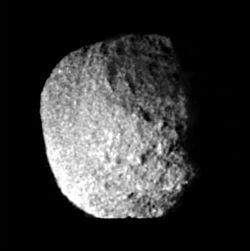Proteus (moon)

Voyager 2 image (1989)
|
|
| Discovery | |
|---|---|
| Discovered by |
Voyager 2 Stephen P. Synnott |
| Discovery date | June 16, 1989 |
| Designations | |
| Adjectives | Protean |
| Orbital characteristics | |
| Epoch 18 August 1989 | |
| Periapsis | 117584±10 km |
| Apoapsis | 117709±10 km |
| 117647±1 km (4.75 RN) | |
| Eccentricity | 0.00053±0.00009 |
| 1.12231477±0.00000002 d | |
|
Average orbital speed
|
7.623 km/s |
| Inclination |
0.524° (to Neptune equator) 0.026°±0.007° (to local Laplace plane) |
| Satellite of | Neptune |
| Physical characteristics | |
| Dimensions | 424 × 390 × 396 km |
|
Mean radius
|
210±7 km |
| Volume | (3.4±0.4)×107 km3 |
| Mass | 4.4×1019 kg |
|
Mean density
|
≈ 1.3 g/cm³ (estimate) |
| 0.07 m/s2 | |
| 0.17 km/s | |
| synchronous | |
| zero | |
| Albedo | 0.096 |
| Temperature | ≈ 51 K mean (estimate) |
| 19.7 | |
Proteus (/ˈproʊtiːəs/ PROH-tee-əs; Greek: Πρωτεύς), also known as Neptune VIII, is the second largest Neptunian moon, and Neptune's largest inner satellite. Discovered by Voyager 2 spacecraft in 1989, it is named after Proteus, the shape-changing sea god of Greek mythology. Proteus orbits Neptune in a nearly equatorial orbit at the distance of about 4.75 equatorial radii of the planet.
Despite being a predominantly icy body more than 400 km in diameter, Proteus's shape deviates significantly from an ellipsoid. It is shaped more like an irregular polyhedron with several slightly concave facets and relief as high as 20 km. Its surface is dark, neutral in color, and heavily cratered. Proteus's largest crater is Pharos, which is more than 230 km in diameter. There are also a number of scarps, grooves, and valleys related to large craters.
Proteus is probably not an original body that formed with Neptune; it may have accreted later from the debris created when the largest Neptunian satellite Triton was captured.
Proteus was discovered from the images taken by Voyager 2 space probe two months before its Neptune flyby in August 1989. It received the temporary designation S/1989 N 1.Stephen P. Synnott and Bradford A. Smith announced its discovery on July 7, 1989, speaking only of "17 frames taken over 21 days", which gives a discovery date of sometime before June 16.
...
Wikipedia
